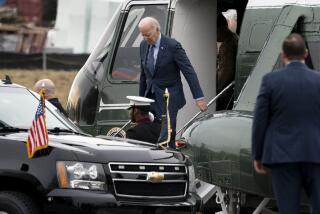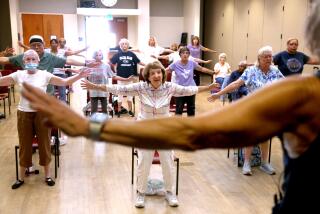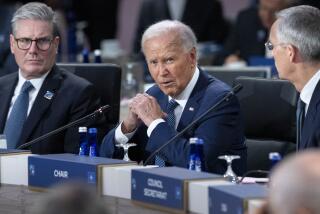For President, It Could Mean a Slower Pace
- Share via
WASHINGTON — For George Bush, more perhaps than any other recent President, a medical order to slow down could require a fundamental change not only in lifestyle but in the conduct of his presidency.
Bush’s play habits, his power walks, speed golf and “walleyball”--volleyball played off the walls of a racquetball court--have become well-known parts of his public image.
More important, however, is the intensely “hands-on” style of his work habits. As President, Bush has logged nearly a quarter of a million miles of travel. He has been in all but three states. He has visited more foreign countries in his first two years of office than Ronald Reagan did in eight. And Bush’s “reach out and touch somebody” style of telephonic diplomacy has become central to U.S. foreign policy.
In the past, Bush routinely has brushed aside advice from aides and friends to take it easier. In the future, he may not be able to do so. As he did two decades ago, when an ulcer led him to change some of the basic habits of his life, the President now at least may have to adjust his approach to his job.
For now, White House officials are insisting that Bush’s condition is minor and that he will soon be able to return to a full schedule. Bush, himself, yelling down to reporters from his hospital window Sunday afternoon, gave an emphatic “yes” when asked if he thought he could continue jogging.
“The doctors have said that,” he said.
But the fact that Bush had to stay another night at Bethesda Naval Medical Center indicates that his problem is at least somewhat more severe than White House officials had indicated Saturday night. Although atrial fibrillation is a somewhat common heart ailment, it can in some cases cause complications, including an increased risk of stroke. In addition, the medication used to stabilize the abnormal heart rhythm can cause both headaches and nausea and is at times difficult to adjust to a proper dose, doctors familiar with the illness say.
And the history of past illnesses in the White House provides reason for skepticism: Reagan’s aides concealed how close he had come to death after being shot, John F. Kennedy’s associates dissembled about his Addison’s disease, Dwight D. Eisenhower’s White House initially tried to cover up his heart attack and Franklin D. Roosevelt went to great lengths to avoid being seen publicly in a wheelchair.
Just as each of those presidents wanted to avoid an image of illness, Bush has reason to try to preserve the picture of youth, vigor and often-boyish enthusiasm, which has been a key part of his public persona.
The image-making has had an impact. In part because of Bush’s vigor, and in part because his predecessor was the oldest President in American history, “we have this President whom nobody thinks of as 66 years old,” said Democratic political consultant Bob Shrum.
If Bush serves eight years, however, he will be older at the end of his term than any President other than Reagan. And already, with his 67th birthday coming up on June 12, Bush is older than all but a handful of former chief executives.
Despite that, the President has made few concessions to aging. Elbow problems have forced him to adjust his tennis game. A few years ago, Bush told reporters that he planned to practice up on golf because knee trouble was forcing him to cut down on running. Where once he routinely ran five miles, now he runs only about two. But as Saturday’s incident showed, he has continued to jog regularly.
Moreover, Bush has kept up a hectic travel pace that has often left both aides and the reporters who follow him haggard. During one four-week stretch last November and early in December, for example, Bush logged 31,920 miles: a 17,000-mile trek through Europe and the Middle East centered on a Thanksgiving Day visit to Saudi Arabia, followed by a two-day trip to Mexico, then an 11,930-mile, six-day journey through South America.
Bush’s schedule just before the onset of his heart problem was typical. Thursday night, he was out for a steak dinner with Secretary of State James A. Baker III and friends; then he was up the next morning to greet the visiting president of Argentina before flying to St. Louis for a speech. Saturday, he was in the air again, this time to Ann Arbor, Mich., for a commencement address at the University of Michigan before returning to his Camp David, Md., retreat, where his problem surfaced as he jogged.
In the past, Bush has resisted suggestions that a slower pace might be better. Nonetheless, “if the doctors tell him to slow down, he’ll slow down,” predicted Peter Teeley, a longtime friend and former press secretary.
Others seemed more skeptical. When asked at the hospital if she thought the President needed to slow his pace, Barbara Bush seemed doubtful of the prospect. “I have been saying that for 40--what--46 years,” she said.
More to Read
Get the L.A. Times Politics newsletter
Deeply reported insights into legislation, politics and policy from Sacramento, Washington and beyond. In your inbox twice per week.
You may occasionally receive promotional content from the Los Angeles Times.











